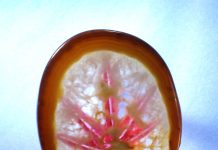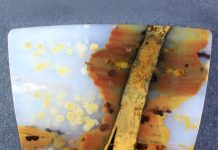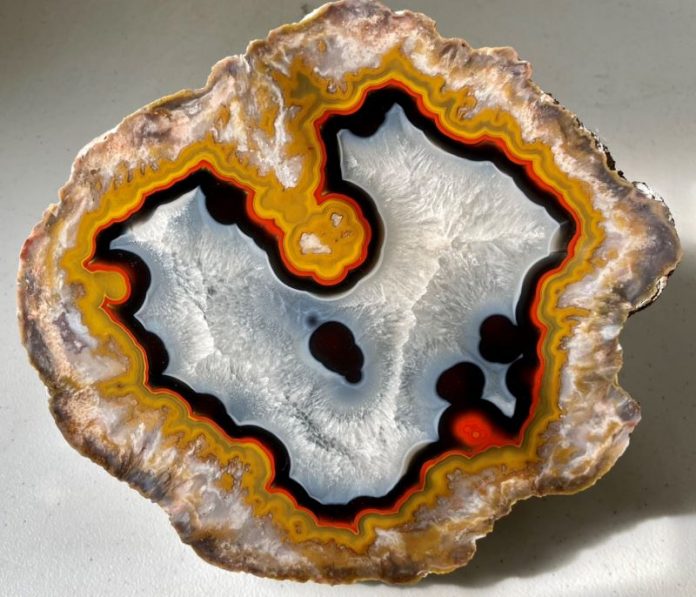
Kentucky agate is breaking into the big leagues, and that’s not easy. In the world of agates, it means competing head-to-head with the likes of South Dakota’s Fairburn agate, Oregon’s fire agate, Montana’s moss agate and Mexico’s blue lace agate.
But Kentucky agate has done just that and more. Thanks to its intense colors and bold banding patterns, it has been honored as Kentucky’s official state mineral, featured in a coffee-table book and celebrated in a regional festival. Along the way, it has spawned new generations of agate collectors, lapidaries and jewelry makers. It is also the raison d’être of a dedicated gem and mineral club—impressive credentials for an agate that was unknown just 50 years ago.
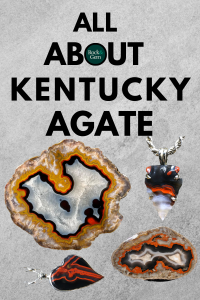 In the Beginning
In the Beginning
Kentucky agate is found only in a relatively small area of east-central Kentucky. Geologists trace its origin to the Mississippian Period more than 300 million years ago when a large river-delta system deposited sediments that lithified into the shales and siltstones of the Borden Formation. Later, a shallow sea laid down sediments that became the limestone and dolomite of the Slade Formation.
The contact between these two formations provided a chemical and physical environment favorable for agate development. The heat and pressure of deep burial first altered organic matter to create voids within the sediments. Regional faults and fractures then enabled silica-rich fluids to circulate through the rock to fill the voids and slowly solidify into nodules of agate. Geologically recent erosion has freed many of these nodules which are now collected in gravels and streambeds.
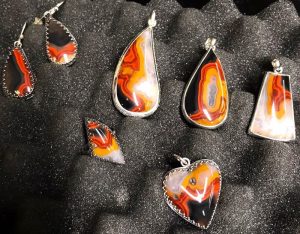
(Adam Gould)
Agate Formation
Agate, a banded, translucent-to-opaque variety of microcrystalline quartz, occurs primarily as nodules or geodes within volcanic rock. A notable exception is Kentucky agate, which is hosted by sedimentary rock.
Agate formation begins when impure, aqueous silica solutions fill cavities and coagulate into thick gels. These gels react with cavity walls to form tough, opaque layers of greenish-brown celadonite, a basic potassium iron magnesium silicate. These celadonite layers, called “rind,” later help separate the nodules from their host rock.
Silica then precipitates onto the celadonite as a thin layer of grayish-white chalcedony, sealing the cavity and creating a closed or partially closed system. Although external pressure may force new solutions into the cavities, the trapped silica gel cannot exit and slowly separates into layers according to differences in chemical composition and density.
As temperatures decrease, solidification progresses from the outside toward the center as the silica gel crystallizes into concentric, varicolored bands of chalcedony. Cavities that are completely filled with silica gel produce solid agate nodules; partially filled cavities create geodes with hollow centers that are lined with drusy coatings of macrocrystalline quartz.

(David Davis)
Kentucky Agate Patterns & Colors
Kentucky agate is characterized by bold, saturated colors along with well-defined banding that varies in color and thickness, and complex banding patterns that combine the features of concentric, fortification, tube and circular “eye” structures.
Kentucky agate’s main colors are red, black, orange and yellow. The red, orange and yellow hues are due to iron. Microscopic particles of hematite (ferrous iron oxide) produce reds; particles of goethite (basic ferric oxide) and/or limonite (a variable mix of iron oxides and hydroxides) create yellows and browns. Changes in its oxidation state determine whether the iron precipitates as red hematite or yellow goethite and limonite minerals. Precipitation of mixed ferric and ferrous iron oxides produces orange hues. The distinctive, jet-black banding in some Kentucky agate is caused primarily by pyrolusite (manganese dioxide). Organic materials such as kerogen and petroleum may also contribute to the black coloration. The presence of these hydrocarbon materials is due to the nearby Big Sinking oil field, Kentucky’s largest oil field, which has produced for more than a century. Low pyrolusite concentrations create pale lavender and blue coloration.
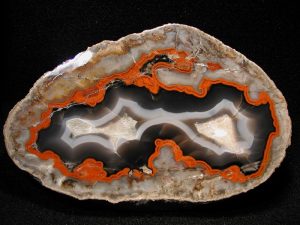
(Wikimedia Commons)
Imperial Agate
The most sought-after and valuable type of Kentucky agate, called “imperial” or “red-and-black” agate, is characterized by bright, saturated red banding in contact with jet-black banding, a color combination not seen in any other agate. Imperial agate is rare; veteran collectors estimate that only one in one hundred specimens exhibit red-and-black coloration. In high demand by both collectors and jewelry makers, top-quality, fist-sized nodules of imperial agate can sell for more than $1,000.
Researchers believe that the first Kentucky agates to form were red and yellow, and originated from iron-rich silica solutions. Agates with lavender, blue and white coloration formed later after iron had largely been depleted from the silica solutions.
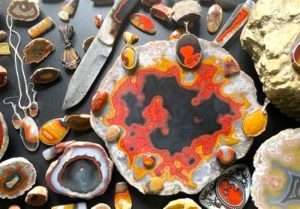
(David Davis)
Kentucky Agate History
Before European contact, Native Americans flaked Kentucky agate into points and tools; later, settlers raked agate nodules from their fields and gardens. Yet this agate was not recognized for its aesthetic or lapidary value until the 1970s when polished slabs and cabochons began attracting attention. By the 1980s, the distinctively colored and prominently patterned agate had earned the name by which it is known today—Kentucky agate.
On July 14, 2000, the Kentucky General Assembly passed House Bill 123 to make Kentucky agate the Bluegrass State’s official rock. But the honor, while certainly warranted, was marred by a nomenclatural error. Because Kentucky already had a state gemstone (freshwater pearl) and a state mineral (coal), Kentucky agate had received the only remaining title—state rock. Agate (quartz), of course, is not a rock, but a mineral. Coal, on the other hand, is a rock.
This naming problem began in 1998 when legislators made coal the state mineral—an oversight rooted in Kentucky’s legal classification of coal as a mineral resource. Finally, in 2024, legislators set the record straight, making coal the Bluegrass State’s official rock and Kentucky agate its official mineral.
In 2013, the University Press of Kentucky published Kentucky Agate: State Rock and Mineral Treasure of the Commonwealth, written by longtime agate collector Roland McIntosh and Kentucky Geological Survey geologist Warren Anderson. This 214-page, full-color coffee-table book documents the story of Kentucky agate with 160 photographs of superb specimens.
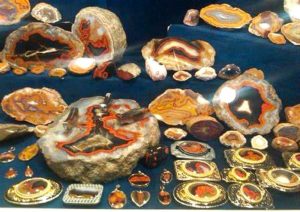
(Wikimedia Commons)
Kentucky Agate Occurrence and Collecting
Kentucky agate occurs within a 250-square-mile tract that covers parts of Powell, Estill, Lee, Jackson and Rockcastle counties. Roughly an hour’s drive southeast of Lexington, this rural area of forested, gently rolling hills is drained by the Kentucky River and its tributaries.
Most Kentucky agate is collected from creek gravels and eroded creek banks; lesser amounts are recovered by digging. Collecting in the creeks is best after spring rains have increased flows to sort gravels and accelerated bank erosion. Although Kentucky agate is not as plentiful as it was in the 1980s, collecting remains productive for those willing to invest the necessary time and effort.
Kentucky agate nodules vary in size from tiny fragments to occasional specimens measuring more than a foot in diameter and weighing 100 pounds. Intact nodules have a nondescript surface appearance and are identified by shapes that are more rounded than those of most other creek-bed rocks. Only fragmented nodules reveal their bright internal colors.
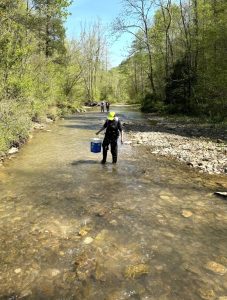
(David Davis)
Kentucky Agate Today
The heart of Kentucky agate country is the town of Irvine, population 2,800 and the county seat of Estill County. Irvine is located on the Kentucky River where the Appalachian foothills meet the Bluegrass country. Irvine’s major annual event, the Mountain Mushroom Festival and Agate Show, is held in late April and celebrates Appalachian culture with a focus on morel mushrooms and Kentucky agate, along with arts, crafts and entertainment.
Morel mushrooms (Morchella esculenta), prized in culinary circles for their meaty texture and earthy flavor, are a gourmet delicacy. They are not cultivated commercially and in years when the harvest from the forests is poor, morels can sell for $100 per pound.
The Southeast Kentucky Gem, Mineral, & Fossil Club, with more than 100 members, hosts the festival’s agate show which is the place to see Kentucky agate in its many forms—rough, cut-and-polished, cabochons and finished jewelry—and talk with expert local collectors, lapidaries and jewelry makers. Especially popular among visitors are the guided agate hunts that are held during the week preceding the Mountain Mushroom Festival and Agate Show. In 2024, more than 125 visitors from states as distant as Massachusetts and Texas participated. Reservations are required and prospective agate hunters should sign up early on the Mountain Mushroom Festival website. Visitors should be also aware that virtually all Kentucky agate-collecting sites are on private property and, as club president David Davis points out, “Folks here take their private property seriously.”
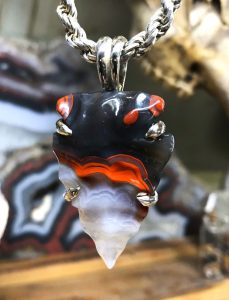
(Adam Gould)
Agate for the Ages
Thanks to its attractive colors and patterns, substantial Mohs hardness of 6.5–7.0, and high levels of durability, workability, abundance and affordability, agate ranks high among the world’s most recognizable and popular gemstones. To add to its appeal, each agate gem or specimen is truly unique; no two agates ever have the exact same colors and banding patterns, even when cut from the same rough.
Archaeologists have dated flaked agate projectile points at more than 100,000 years and crudely polished agate amulets at 20,000 years. Many cultures have believed that agate had the power to bring good fortune, assure good harvests and even cure insomnia.
Greek philosopher and naturalist Theophrastus named agate akhatēs after finding the stone in the Achatēs River (now the Dirillo River) on Italy’s island of Sicily. About 1450 C.E., the Greek word passed into German as achat and a century later was anglicized to “agate.”
Modern metaphysical practitioners believe that agate helps to discern truth, accept circumstances, recall the past and focus one’s mental energy. Agate is an alternative birthstone for September; an astrological birthstone for Gemini, and the gemstone for the 12th wedding anniversary. It is also the official gemstone or mineral of nine states: Arizona, fire agate; Kentucky, Kentucky agate; Louisiana and Tennessee, agate; Minnesota, Lake Superior agate; Montana, moss agate; Nebraska, blue agate; Oregon, agate-filled thundereggs; and South Dakota, Fairburn agate.
This story about Kentucky agate previously appeared in Rock & Gem magazine. Click here to subscribe. Story by Steve Voynick.


